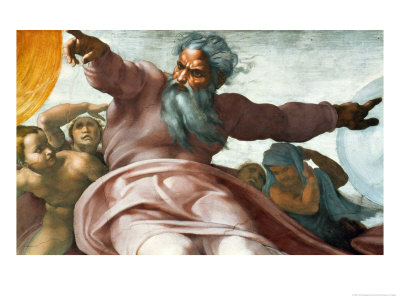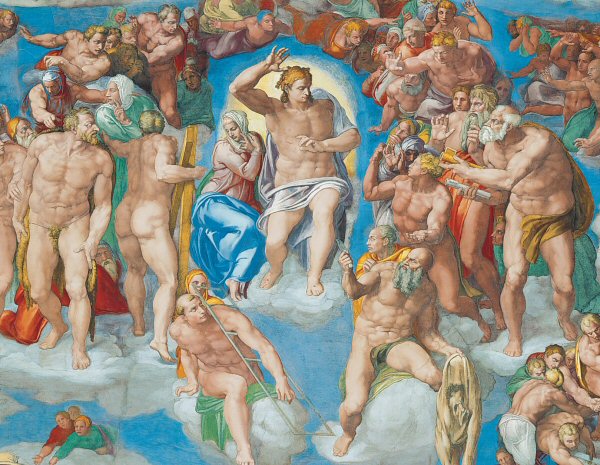As my travel buddy so rightly proclaimed: 'There are few things which live up to expectations after you've heard so much about them and seen photos your whole life. But the Sistine Chapel, despite familiarity, is overwhelming in person; it is awe-inspiring and surpasses expectations.' For me, having studied each panel of that fresco until its shapes, colors, and characters were memorized in order to satisfy an educational requirement, my own expectations were dashed to smithereens when I compared textbook information and history to the artistry and energy of the real thing. When we entered, the cavernous, dark room, though entirely packed with people, was whisper-quiet. Each person's eyes were aimed skyward, drinking in the majesty of the masterpiece surrounding them.
 |
| For a really, really good panoramic shot of the whole room (with excellent zoom features) CLICK HERE!!! |
| Sistine Chapel vertical scheme |
Knowing Michelangelo's life story, particularly his resentment of the project, makes this commissioned work of art – his crowning achievement in painting many would argue – that much more fascinating. The barrel vault ceiling was originally painted brilliant-blue and dotted with gold stars until Pope Julius II commissioned a series of paintings in the early 1500s. Although Michelangelo's complex design for the ceiling was not quite what his patron, Pope Julius II, had in mind when he commissioned Michelangelo to paint the Twelve Apostles, the scheme displayed a consistent pattern; God's Creation of the World, God's Relationship with Mankind, and Mankind's Fall from God's Grace. However, this was disrupted by a further commission to Michelangelo to decorate the wall above the altar with The Last Judgement, 1537–1541. The painting of this scene necessitated the obliteration of two episodes from the Lives, several of the Popes and two sets of Ancestors.
The painted area is about 131 ft long by 43 ft wide. This means that Michelangelo painted well over 5,000 square feet of frescoes.
Stefania spoke to us quietly inside the Chapel, and while I new quite a bit about the artist and the art I knew very little of its recent restoration, a project that took nearly as long as the actual creation of the art, itself. “A close examination of the frescoes of the lunettes convinced the restorers that Michelangelo worked exclusively in 'buon fresco'; that is, the artist worked only on freshly laid plaster and each section of work was completed while the plaster was still in its fresh state. In other words, Michelangelo did not work 'a secco'; he did not come back later and add details onto the dry plaster.
 |
| Before and After restoration |
The difference is extraordinary:
 |
| After restoration |
<<< Michelangelo's Pieta was just as moving and, given its three dimensions, was astonishingly lifelike. It was placed behind glass in St. Peter's Basilica in first chapel on the right in relation to the main entrance after attempted murder. Yes, this statue was attacked. “The most substantial damage occurred on May 21, 1972 (Pentecost Sunday) when a mentally disturbed geologist named Laszlo Toth walked into the chapel and attacked the sculpture with a geologist's hammer while shouting 'I am Jesus Christ.' Onlookers took many of the pieces of marble that flew off. Later, some pieces were returned, but many were not, including Mary's nose, which had to be reconstructed from a block cut out of her back.” Thankfully, with the help of professional artists she fully recovered. But as a lasting result, no casual viewer can get within 15 or so feet from the pair.
This famous work of art depicts the body of Jesus on the lap of his mother Mary after the Crucifixion. It is the only piece Michelangelo ever signed. Those with a keen eye will notice that the structure is pyramidal, and the vertex coincides with Mary's head. The statue widens progressively down the drapery of Mary's dress, to the base. Though the relationship and placement of the figures seems quite natural, they are grossly out of proportion. This was intentionally done, of course, owing to the difficulty of depicting a fully-grown man cradled full-length in a woman's lap.
Also, Michelangelo's interpretation of the Pieta was far different from those previously created by other artists, as he sculpted a young and beautiful Mary rather than an older woman around 50 years of age. It is thought that he did this, in part, to pay homage to his own mother as well as to suggest incorruptible beauty. The face of the second figure, Christ after The Passion, reveals no sign of the excruciating death he just suffered. Michelangelo did not want his version of The Pieta to represent death, but rather to show the “religious vision of abandonment and a serene face of the Son.”







No comments:
Post a Comment
Note: Only a member of this blog may post a comment.